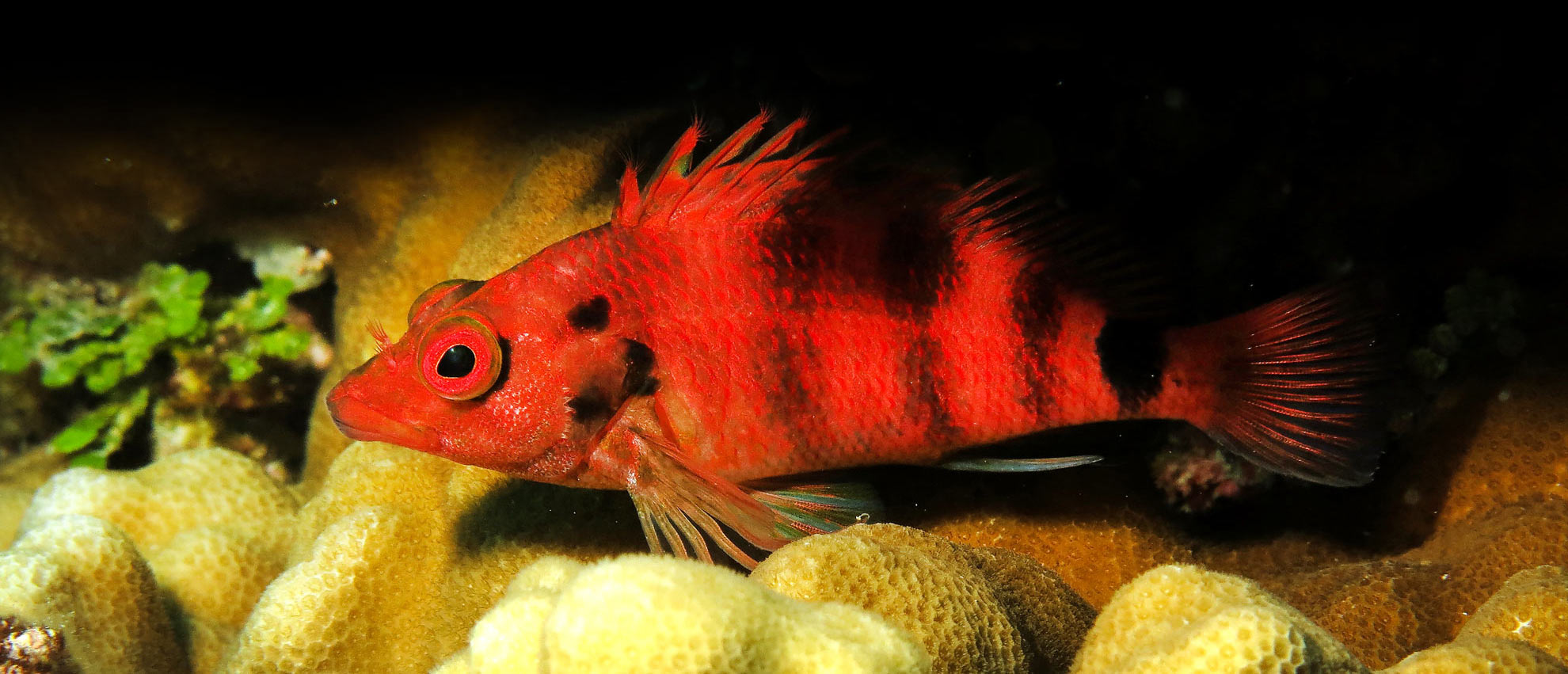by Iván Hinojosa
For many the night is a mystery, an enigma and frightening. For others, it is attractive, motivating and seductive, where many species, not only marine ones, are totally active. What does the night conceal in the depths of the seas off of Rapa Nui? For others, it is attractive, motivating and seductive, where many species, not only marine ones, are totally active. What does the night conceal in the depths of the seas off of Rapa Nui? Could our eyes be capable of discovering those secrets?
Practicing nighttime diving on Rapa Nui opens the doors to a world which is usually hidden and surprising. Many fish and an equal number of invertebrates have periods of nocturnal activity, whether it be feeding or protecting themselves from predators. For a long time, the nocturnal activity of these species has been well known by the inhabitants of Rapa Nui, especially the hunters of lobsters, Ura (Panulirus pascuensis), and slipper lobsters, Rape-rape(Parribacus perlatus) and (Scyllarides roggeveeni). Hunting of these crustaceans is much easier during the night when these invertebrates come out of their caves to feed. These species are a valuable resource due to their high demand in gastronomic circles. Unfortunately, as a result of intensive extraction, the populations of these crustaceans apparently have been heavily diminished in recent years, which poses a potential threat to the conservation of these species and to the equilibrium of the ecosystem.

In order to evaluate and confirm the loss of the populations of these and other species, a group of researchers from the Ecology and Sustainable Management of Oceanic Islands – ESMOI held dives both during the day and at night in March of 2016. They followed strict scientific methods in sites near Hanga Roa and Anakena. What we found was totally unexpected. When we submerged at night, we were surprised and amazed
to see the wide diversity and the differences in species compared to daytime diving. One of the most striking, abundant and diverse of the group of species is the Hotake, or sea cucumbers (Holothuroidea). They feed, principally, on small organic particles buried in the sand or on the corals. Other species filter organic particles suspended within the water. The Hotake are commonly considered marine vacuum cleaners because they keep the ecosystem clean.

Other species of invertebrates which are active during the night are the Koro Uraor rock shrimp (Rhynchocinetes spp.), although we aren’t yet sure to which species they belong, and small Pikea, or coral crabs (Trapezia punctimanus). Both of these possibly feed off of carrion. The most abundant fish at night are tiki soldierfish, Mārau (Myripristis tiki), squirrelfish Mārau hiva (Sargocentron wilhelmi) and Wilhelm’s hawkfish, Piliko’a (Itycirrhitus wilhelmi), along with some moray eels, Kōreha and conger eels, Ko ‘iro, which also show greater activity at night.
As we observed the particular characteristics of these species, we realized that some of the invertebrates which appear at night are primarily concerned with keeping their surroundings clean by consuming organic particles and carrion. Among the fish, those which are reddish-colored come out of their caves. In the marine environment, the color red is almost invisible for many species, so this coloration possibly serves as camouflage, allowing them to feed without being spotted by their prey or their predators.

Investigating in the data bases and scientific publications from other parts of the world, we were to surprised to discover that little data exists on the differences of species which appear in the day and the nocturnal ones. Most scientific dives which study diversity in species are done during the daylight hours, but it has become obvious that diversity was being underestimated by not including the nocturnal activity of some species which are barely noticed during the daytime.
In spite of the efforts made during the night dives on Rapa Nui, only a few Uralobsters and Rape-rape slipper lobsters appeared in our observations. Compared to historical accounts which indicate a great abundance just thirty years ago, it becomes evident that the numbers of these important fishing species have diminished in the places that were evaluated. To avoid the potential disappearance of these species and maintain this important economic activity will require the urgent formation of resource management measures with the active participation of the community.
The ESMOI team has recently taken on a project sponsored by the Fund for Fisheries and Aquaculture (FIPA) to evaluate the present situation of coastal fisheries of importance on Rapa Nui and further develop the preliminary observations, in order to generate and implement measures of conservation for the sustainable development of this productive activity, together with the local community.
















